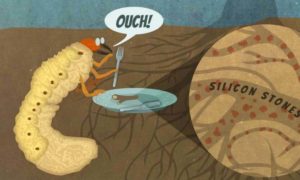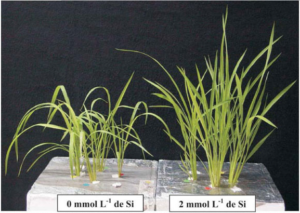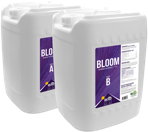Silica Supplements
Share this Post
ARE THEY WORTH IT?
Essential plant nutrients are classified as such if they are required for the function of plant metabolism. To date, there are 17 known essential plant nutrients, but there are also some elements that are considered to be beneficial to plant health and growth. This means that the plant’s metabolism will function without them, but there are significant benefits to plant growth and performance with them.
Silicon is the second most abundant element in the earth’s crust; silicon dioxides, the form of silicon found in soil, may make up almost 50% of soil volume. Although silicon (chemical symbol Si) is not yet considered an essential plant nutrient, the beneficial effects of Si have been observed extensively, especially in plants under stress. The increased resistance to bacterial and fungal diseases and pest pressures is also well documented. Among the diseases observed, silicon increased plant resistance to bacterial leaf spot, blights and powdery mildew. Insect suppression towards borers, leaf hoppers and mites has also been recorded.

Figure 1: Pest Resistance
The resistance to pathogens is mostly provided by a physical barrier caused by silicon deposits in cells of roots, stems and leaves. A stronger physical barrier inhibits chewing and biting insects, making the plant less susceptible to insect damage. Plants treated with Si may also produce phenolics and phytoalexins in response to fungal infections. Phenolic compounds, which include cannabinoids, are a naturally occurring by-product of the plant’s immune system. Phytoalexins, which include terpenoids, are natural antimicrobial and antioxidant compounds made by plants.
Silicon application can reduce chemical stress induced by nutrient toxicities or deficiencies. Si can also help prevent water stress by protecting the plant during excess transpiration that occurs during water stress or low light conditions. Plants given supplemental Si have shown increased rates of photosynthesis and more rigid stems and leaves (Figure 2).
With all of these benefits, why shouldn’t we supplement all plants with silica? The solubility and transport of silica within the plant begs a deeper explanation. Solubility is typically very low, with an extreme affinity for oxygen, so soil Si usually exists as silicates or silica sand. Soil temperature, saturation and pH all factor into Si solubility. The lower the pH, the higher the solubility. At pH below 8.0, soil Si most likely exists as silicic acid, which is the form that plant roots uptake.

Figure 2: Plants on right were given supplemental Si.
Different plant species accumulate varying concentrations of Si in tissues. Monocots (grasses, cereal grains) accumulate Si at much greater concentrations than dicots (Cannabis, cucumbers, tomatoes). Rice accumulates silica in very large amounts and this can vary from 50 ppm in rice bran to 350 ppm in rice joints (base of the plant). Monocots supplemented with as little as 50 ppm of silica will have more than enough available silica for accumulation. Although pH and soil composition may modify it, the form of silicon that plants generally use is monosilicic acid, or H4SiO4. Once roots absorb this, solid silica deposits are made in plant cells.
Sources of silicon include potassium silicate, sodium silicate, diatomaceous earth (DE) and silicic acid. Si amendments or additives can be applied as a foliar or as a soil amendment. It is not recommended to mix silica supplements with other fertilizers as the alkaline nature of silicon will likely cause precipitation of other nutrients. This can also cause a large pH shift in the growing medium, further limiting the availability of other nutrients. Silica also may compete for uptake with phosphate since they are chemically similar. Caution should be used to avoid combining the two in nutrient solutions in order to prevent competition.
Although silicon may not be considered an essential plant nutrient, there is abundant research confirming the benefits of supplementation on plant resilience and disease resistance. While not required for plant growth, adding moderate amounts of silicic acid to your nutrient program may optimize the health and performance of your garden.
REFERENCES
Currie HA, Perry CC. 2007; Silica in Plants: Biological, Biochemical and Chemical Studies. Ann Bot. 100 (7): 1383-1389.
Barker AV, Pilbeam DJ (2015) Handbook of Plant Nutrition, 2nd ed. CRC Press, Boca Raton, FL
Datnoff LE, Elmer WH, Huber DM (2015) Mineral Nutrition and Plant Disease, 5th ed. APS Press, St Paul, MN.

